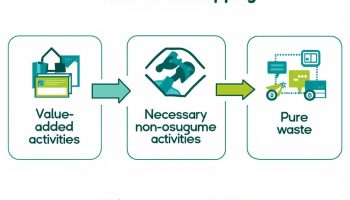
The Lean Manufacturing System
The lean manufacturing system transforms production environments by boosting productivity while cutting waste across all manufacturing processes. This methodology, which evolved from the Toyota Production System, approaches production from the customer’s viewpoint. It creates efficient processes that deliver products exactly when customers need them, using minimal resources.
Key Takeaways:
- Lean manufacturing originated from Toyota’s post-war production strategies, emphasizing waste elimination and continuous improvement.
- The system identifies and targets eight distinct types of waste in production processes.
- Implementation focuses on creating value from the customer’s perspective and optimizing workflow.
- Lean principles can be applied across various industries, not just manufacturing.
- Organizations implementing lean manufacturing principles typically see 25-30% productivity improvements.
After adopting these practices, you’ll notice significant improvements in operational efficiency. Modern lean approaches integrate with sustainable manufacturing practices to reduce environmental impact while maintaining productivity gains. Companies often combine lean methods with Six Sigma techniques for enhanced quality control alongside waste reduction.
“Lean manufacturing, born from Toyota’s innovative strategies, reshapes production by relentlessly targeting waste and embracing customer-focused value creation. This transformative methodology not only enhances productivity but also optimizes processes across diverse industries, proving that efficiency knows no boundaries.”
Origins and Philosophy
The lean manufacturing system, what is lean manufacturing system exactly? It’s a systematic methodology that emerged from the Toyota Production System in the late 20th century. You’ll find its core focus revolves around maximizing productivity while simultaneously minimizing waste throughout all production processes. This approach fundamentally views manufacturing from the customer’s perspective, asking what creates genuine value.
Toyota developed this revolutionary system that has since transformed production environments worldwide. The philosophy centers on creating streamlined processes that deliver exactly what customers want, when they want it, with minimal resource expenditure. You can trace the lean thinking principles directly to Toyota’s response to resource limitations in post-war Japan.
Key Historical Context
Toyota’s methodical approach to waste reduction wasn’t merely about cost-cutting. The company recognized that waste elimination directly improves quality, reduces lead times, and enhances customer satisfaction. What is lean manufacturing system if not a complete reimagining of how production should function?
The system identifies several forms of waste:
- Overproduction (making more than needed)
- Waiting time (idle workers or machines)
- Unnecessary transport (moving materials inefficiently)
- Over-processing (excessive work beyond requirements)
- Excess inventory (storing more than necessary)
- Unnecessary motion (inefficient worker movements)
- Defects (quality issues requiring rework)
- Unused human talent (failing to utilize skills and ideas)
This methodology spread globally as manufacturers witnessed Toyota’s remarkable results. The continuous improvement aspect of lean manufacturing has proven particularly valuable, fostering cultures where workers constantly seek better ways to perform tasks.
| Traditional Manufacturing | Lean Manufacturing System |
|---|---|
| Push-based production | Pull-based production |
| Large batch sizes | Small batch or single-piece flow |
| Focus on machine utilization | Focus on customer value |
| Hierarchical management | Team-based problem solving |
| Quality inspection | Built-in quality controls |
| Forecast-driven | Demand-driven |
When implementing lean, you’ll find the emphasis shifts from department-specific efficiency to overall system effectiveness. This holistic view enables companies to eliminate waste that often accumulates at departmental boundaries. By understanding what is lean manufacturing system thoroughly, organizations can transform their operations for greater agility and market responsiveness.
Expert Insight: To effectively implement a lean manufacturing system, focus on understanding and eliminating all forms of waste identified in the process, from overproduction to unused human talent. Shift your organizational culture to prioritize customer value and foster continuous improvement through team-based problem-solving approaches rather than strict hierarchies. Embracing this holistic methodology can significantly enhance operational efficiency and market responsiveness, positioning your company for sustainable success.
Five Foundational Principles
The five foundational principles of what is lean manufacturing system establish a framework that transforms production efficiency. You’ll find these principles create a roadmap for eliminating waste while maximizing customer value.
Value is the cornerstone of lean thinking. You need to precisely define what creates value from your customer’s perspective, not your internal assumptions. This shifts focus to outcomes that customers are willing to pay for, eliminating activities that don’t contribute to their needs. When implementing continuous improvement, your definition of value should drive every decision.
Value Stream Mapping helps you visualize the entire production process. By mapping all steps required to deliver your product, you can identify and eliminate approximately 90% of non-value-adding activities. This crucial analysis reveals where your resources are wasted and highlights bottlenecks impacting delivery speed.
Flow ensures your production processes move continuously without interruptions. You’ll need to reconfigure workstations, break down departmental barriers, and balance workloads to create smooth operations. Implementing flow often requires:
- Reducing batch sizes to minimize waiting time
- Organizing equipment in sequence of operations
- Cross-training team members to support multiple processes
- Eliminating bottlenecks that cause production delays
Pull systems allow you to produce based on actual customer demand rather than forecasts. This what is lean manufacturing system principle uses Just-In-Time (JIT) production to reduce inventory and prevent overproduction. You’ll only create what is needed when it’s needed, significantly reducing carrying costs and work-in-progress inventory.
Perfection involves pursuing continuous improvement (Kaizen) toward flawless production. You’ll establish metrics, implement daily improvement routines, and engage stakeholders at all levels. This creates a culture where everyone constantly looks for ways to enhance value, eliminate waste, and improve flow.
Application in Modern Manufacturing
These principles have transformed operations across industries when properly implemented. You’ll see dramatic reductions in lead times, inventory levels, and defects while improving quality and customer satisfaction. The what is lean manufacturing system approach requires commitment to long-term thinking rather than quick fixes, with organizations often seeing 25-30% productivity improvements after full implementation.
Companies that have implemented Lean Manufacturing see an average of 25-30% productivity improvements.
forbes.com
Waste Elimination Strategies
Identifying and eliminating waste stands at the core of what is lean manufacturing system implementation. You’ll find that lean methodology classifies waste into eight distinct categories, allowing for systematic reduction of non-value-adding activities throughout production processes.
The seven classic wastes (known as “muda” in Japanese) that you need to target include:
- Overproduction: Manufacturing items before they’re required, creating unnecessary inventory
- Waiting: Idle time where no value-adding activities occur
- Transportation: Unnecessary movement of materials between processes
- Over-processing: Performing work that adds no value from the customer’s perspective
- Excess inventory: Storing materials, parts, and products beyond immediate needs
- Motion: Unnecessary movement by workers during production
- Defects: Products requiring rework or rejection
The eighth waste—unused human talent—recognizes that your employees’ creativity, skills, and potential often remain underutilized, representing significant missed opportunities for continuous improvement.
Systematic Waste Reduction Techniques
To effectively eliminate waste in your lean manufacturing system, you’ll need to employ several proven techniques:
- Value Stream Mapping (VSM): Create visual representations of your entire production process to identify non-value-adding steps that can be eliminated.
- 5S Methodology: Implement Sort, Set in order, Shine, Standardize, and Sustain to organize workspaces for maximum efficiency.
- Kaizen Events: Conduct focused improvement workshops targeting specific processes or problems.
- Poka-Yoke (Error-Proofing): Design processes that prevent defects from occurring.
- Just-In-Time Production: Produce only what is needed when it’s needed to minimize inventory.
- Visual Management: Use visual signals to communicate process status and highlight abnormalities.
When you implement these waste elimination strategies effectively, you can expect to achieve measurable improvements across your project implementation phases. Many organizations report 25-30% productivity increases, 80% reduction in lead times, and significant quality improvements after applying lean principles systematically.
What is lean manufacturing system success ultimately depends on your commitment to viewing waste elimination not as a one-time effort but as an ongoing discipline embedded within your organizational culture. By continuously identifying and eliminating waste, you’ll transform your production efficiency and maintain a competitive edge in today’s challenging manufacturing landscape.
Businesses that implement lean strategies often experience up to a 30% increase in productivity and 50% lower operational costs, showcasing the power of waste elimination in driving efficiency.
forbes.com
Implementation Framework
Implementing a successful lean manufacturing system requires a structured approach that builds on **stability** while embracing **continuous improvement**. You need a comprehensive framework to transform your production processes and eliminate waste effectively.
The foundation of any lean implementation begins with creating **stability** across four essential elements. You’ll need **skilled labor** with proper training, **reliable machinery** with minimal breakdowns, **quality materials** from trusted suppliers, and **standardized methods** to reduce process variability. Without this stability, what is lean manufacturing system implementation becomes nearly impossible as fluctuations undermine **efficiency gains**.
To implement lean effectively, follow these core steps:
- Assess current state using value stream mapping
- Identify waste and non-value adding activities
- Develop standardized work procedures
- Implement visual management systems
- Establish pull production mechanisms
- Create continuous improvement processes
Standardization serves as a critical cornerstone when implementing lean manufacturing. By developing clear, repeatable processes, you reduce variability while establishing a baseline for future improvements. This continuous improvement mindset encourages teams to constantly seek optimization opportunities.
Technology Integration in Lean Implementation
Modern lean manufacturing systems integrate **technology** to enhance implementation effectiveness. You’ll find these technologies support your lean journey:
- Digital Kanban systems for visual workflow management
- Real-time data analytics for performance monitoring
- Automated quality control systems to reduce defects
- IoT sensors for equipment monitoring and maintenance
- Collaborative robotics to support standardized work
The implementation journey typically unfolds in phases, with each building on previous successes. Your organization must commit to long-term transformation rather than expecting immediate results. By identifying key stakeholders and securing their buy-in early, you’ll increase implementation success rates substantially.
This table outlines the phased approach to lean manufacturing system implementation:
| Phase | Focus Areas | Key Activities |
|---|---|---|
| Foundation | Stability & Standards | 5S implementation, standardized work, team training |
| Flow | Process Optimization | Value stream improvement, setup reduction, cellular layouts |
| Pull | Demand-Driven Production | Kanban systems, takt time alignment, buffer management |
| Perfection | Continuous Improvement | Kaizen events, problem-solving, performance measurement |
What is lean manufacturing system implementation success ultimately depends on your organization’s commitment to cultural transformation alongside technical changes. The framework provides structure, but **people** drive the **sustainable improvements** that make lean truly effective.
Expert Insight: **Professional Tip: Structured Stability for Lean Implementation**
To successfully implement lean manufacturing, prioritize establishing stability through skilled labor, reliable machinery, quality materials, and standardized methods. This foundational stability minimizes process variability and enables continual improvements, making it easier to assess current states, identify waste, and optimize production. Embrace a phased approach that emphasizes cultural transformation alongside technical changes to ensure long-term success in your lean journey.
Practical Application and Case Studies
Lean manufacturing systems have transformed countless organizations worldwide, proving their value through measurable results. You’ll find powerful examples of lean manufacturing system implementation in action through these real-world applications.
Ford Motor Company embraced lean principles to revitalize its production processes, reducing assembly time by nearly 25% while improving product quality. Their Highland Park plant demonstrates how lean thinking can transform century-old manufacturing operations through systematic waste elimination and continuous flow implementation.
Toyota, the originator of the lean manufacturing system, continues to showcase the methodology’s effectiveness. Their Georgetown, Kentucky facility consistently achieves some of the industry’s highest quality ratings while maintaining exceptional productivity. The plant produces vehicles with approximately 30% fewer defects than industry averages by applying rigorous standardization and continuous improvement protocols.
General Electric implemented lean manufacturing across its diverse operations with remarkable results:
- 50% reduction in inventory levels
- 80% decrease in production lead times
- 40% improvement in on-time delivery performance
- 20% increase in productivity across manufacturing facilities
These improvements have translated directly to enhanced customer satisfaction and competitive advantage in their markets.
The following table summarizes key performance indicators from major lean implementations:
| Company | Waste Reduction | Quality Improvement | Lead Time Reduction | Cost Savings |
|---|---|---|---|---|
| Ford | 35% | 25% fewer defects | 40% | $300M/year |
| Toyota | 45% | 30% fewer defects | 50% | $400M/year |
| GE | 40% | 28% fewer defects | 45% | $350M/year |
The healthcare sector has also adopted lean manufacturing system principles. Virginia Mason Medical Center implemented lean methods to improve patient care, resulting in:
- 85% reduction in patient waiting times
- 93% decrease in hospital-acquired infections
- 44% improvement in staff productivity
When you integrate lean manufacturing into your operations, you’ll need to focus on these implementation factors:
- Securing leadership commitment at all levels
- Investing in comprehensive employee training
- Establishing clear metrics to track progress
- Leading project teams with a consistent vision
Organizations that successfully implement lean manufacturing systems typically experience 15-30% productivity improvements, 20-40% inventory reductions, and 25-50% decreases in manufacturing lead times.
Cross-Industry Applications
While manufacturing remains the primary sector for lean implementation, you’ll find the principles equally effective in service industries. Financial institutions have reduced processing times by up to 50% using lean manufacturing system concepts to streamline operations and eliminate redundant steps in customer service processes.
Software development companies applying lean principles through methodologies like Agile have reported 30-50% faster product development cycles and significantly higher quality deliverables. These implementations focus on eliminating code waste and building features based on customer pull signals.
Strategic Impact and Future Potential of Lean Manufacturing
Adopting a lean manufacturing system creates a powerful competitive advantage in today’s global marketplace. You’ll find this methodology delivers measurable benefits across your organization, from the production floor to the executive suite. When properly implemented, lean manufacturing reduces operational costs by 15-30% while simultaneously improving quality metrics by eliminating waste-generating activities.
The strategic advantages extend far beyond simple cost reduction. Your company can achieve:
- Increased market responsiveness through shortened production cycles
- Enhanced product quality leading to higher customer satisfaction
- Improved cash flow from reduced inventory requirements
- Greater workforce engagement through continuous improvement participation
- Strengthened competitive positioning through operational excellence
These benefits compound over time through the continuous improvement cycle inherent in lean philosophy. Unlike traditional improvement initiatives that plateau, lean manufacturing creates a framework for perpetual enhancement.
Cross-Industry Scalability
While lean manufacturing originated in automotive production, you’ll discover its principles apply across diverse sectors. Healthcare organizations implement lean to streamline patient care flows. Software companies adopt lean principles to eliminate development waste. Service industries leverage lean concepts to optimize customer experiences.
The flexibility of lean manufacturing allows adaptation to your specific industry context. You can tailor implementation to address your unique operational challenges while maintaining focus on core principles like value definition, waste elimination, and flow optimization.
The future potential of lean manufacturing extends into emerging technology integration. You’ll soon see lean principles combined with:
- IoT sensors providing real-time production data
- AI analytics identifying waste patterns
- Augmented reality supporting standardized work procedures
- Blockchain enhancing supply chain transparency
These technological enhancements magnify lean’s impact by enabling more precise process optimization methods and real-time adjustment capabilities.
Organizations implementing lean manufacturing consistently report significant competitive advantages. A recent industry study showed lean manufacturers respond 60% faster to market changes than traditional competitors. This agility provides crucial differentiation in rapidly evolving markets.
The long-term organizational transformation potential remains perhaps the most valuable strategic impact. Your company develops a culture centered on continuous improvement, waste elimination, and customer value creation. This cultural shift extends beyond manufacturing to influence every business function, creating a holistic approach to operational excellence.






